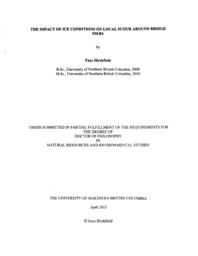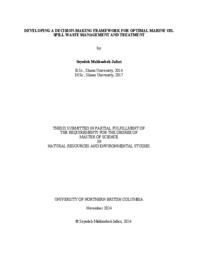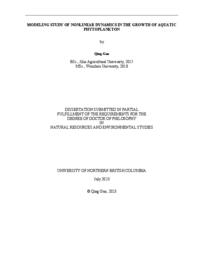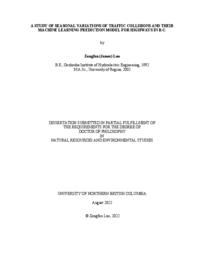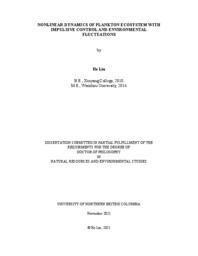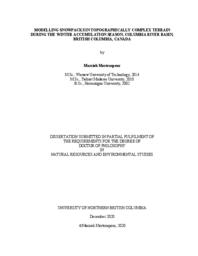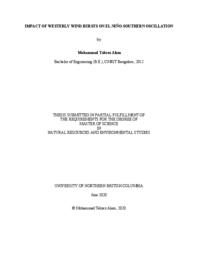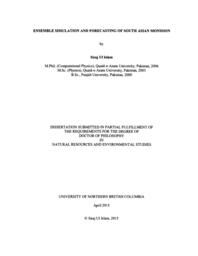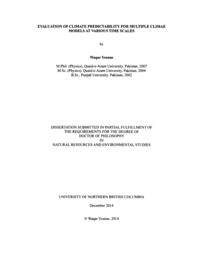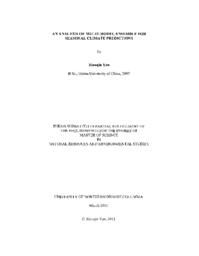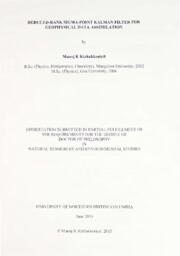Tang, Youmin
Person Preferred Name
Youmin Tang
Related Works
Content type
Digital Document
Origin Information
Content type
Digital Document
Description / Synopsis
This research explores estimating off-shore oily waste, considering waste-waste compatibility due to the heterogeneous nature of oily waste. Firstly, hyperparameters for Artificial Neural Networks (ANN), Support Vector Regression (SVR), and Improved Random Forest (IRF) models are optimized to develop a comprehensive oily waste estimation model incorporating liquid, solid, and total waste types. The results show that IRF is the most accurate model, with the lowest error indices and a higher correlation coefficient compared to ANN and SVR. This study then takes a step further to propose a waste allocation framework, which is tested using information on the Bella Bella oil spill incident in British Columbia. Incorporating treatment and receiving facilities' details, such as their location and capacity, the framework distinguishes all possible waste pathways for handling the waste from source to landfill. Genetic Algorithm (GA) is introduced to optimize waste transfer processes and successfully minimize transportation costs. The results show that the model can find the most optimized path to reduce transportation costs. The model's high customization, adaptability, and capacity to consider multiple nodes make it suitable for complex waste transfer networks, demonstrating its practicality in emergency situations. Efficiently allocating resources and ensuring cost-effective waste transportation while considering facility capacities and waste compatibility, the study holds practical implications for waste management practitioners, environmental authorities, and response teams.
Origin Information
Content type
Digital Document
Description / Synopsis
Phytoplankton bloom has become a growing global concern in recent years due to the excessive growth of algae, causing significant negative impacts on aquatic ecosystem and threatening human health. Growing evidence suggests that algal blooms are a consequence of the interplay of various hydrodynamical, chemical, and biological processes in aquatic systems. The complexity and nonlinearity of aquatic ecosystems, and the complexity of climatic and hydrographic events, make interpreting and predicting the blooms a very challenging task. In recent years, many different strategies have been adopted to manage algal blooms. Among them, mathematical models are advantageous because they can capture the ubiquitous stoichiometric constraints for modeling species growth and interaction. Thus, mathematical models have been widely used to investigate the dynamics of phytoplankton growth. In this study, five mathematical models were developed based on population dynamics, ecological dynamics, dynamic modeling, and probability theory. The models were investigated theoretically and numerically in terms of the theory of partial differential equations, stochastic differential equations, impulsive differential equations, and numerical simulation. The objective of this dissertation research was to gain insight into plankton dynamics and explore potential management strategies for excessive algal growth in aquatic systems. The main results are presented as follows: Firstly, a nutrient-plankton model incorporating delay and diffusion was developed. The theoretical analysis revealed that delay can trigger the nutrient-plankton oscillation via a Hopf bifurcation. Especially, the stability switches for positive equilibrium occur with increasing delay, which indicates that delay can generate and suppress the unstable coexistence of species population. Numerical results reveal that the stability switches for positive equilibrium indeed exist in the model, and the homogeneous multiple periodic solutions, as well as chaos, can occur with different values of delay, which implies that the model exhibits delay-induced complex dynamics. Secondly, a stochastic Leslie-Gower phytoplankton-zooplankton model with prey refuge was developed. The dynamical analysis revealed the sufficient conditions for the persistence and extinction of plankton populations. The numerical simulations showed that environmental noise and prey refuge play a crucial role in the survival of plankton species. The results further demonstrate that prey refuge can enhance the oscillation range of phytoplankton population, but the variance of zooplankton tends to increase and then decrease as prey refuge increased. Thirdly, considering seasonal disturbances in aquatic ecosystem, a stochastic nutrient-phytoplankton model with seasonal fluctuation was developed. The results indicate that periodic solutions exist under certain conditions, suggesting that plankton populations are associated with periodic oscillations. Furthermore, numerical results showed that seasonal fluctuation can trigger periodic blooms of phytoplankton and promote the coexistence of plankton species. Specifically, the results indicate that phytoplankton is more sensitive to nutrient than to seasonal fluctuation. Fourthly, a stochastic nutrient-plankton model with regime-switching was developed by considering regime-switching plankton mortality. The results showed that the model admits a stationary distribution under certain conditions. Then the numerical analysis revealed that the persistence and extinction of plankton populations are sensitive to variations in nutrient input. The numerical results also indicate that regime-switching plankton mortality contributes to the survival of plankton populations in the aquatic system. Finally, a stochastic nutrient-plankton model with impulsive control was developed. The theoretical analysis established sufficient conditions for the existence of periodic solutions. In addition, the numerical analysis showed that nutrient impulse plays an important role in preventing and controlling algal blooms, and appropriate environmental fluctuation can promote the coexistence of phytoplankton and zooplankton populations. However, excess intensity noise can result in the collapse of the entire ecosystem.
Origin Information
Content type
Digital Document
Description / Synopsis
Traffic collisions are considered as one of the world’s major public health problems. According to the World Health Organization (WHO), about 1.3 million people die every year in traffic collisions across the world and a further 20 - 50 million are injured or disabled. Various tools/methods were developed to assess highway safety. Historically, collision frequency, collision rates, linear regression and generalized linear regression, and Bayesian modeling methods have been used as the basis for safety analysis. Research has shown that there are limitations with this approach due to the non-linear relationship between collision frequency and exposure. Traffic volume is directly related to traffic exposure, traffic exposure affects collision risk and collision risk significantly determines the probability of traffic collision occurring. The different traffic exposure has a different level of effects on collision risk, and different level of collision risk results in the different probability of collision occurring and collision severity. Collision prediction modeling (Safety Performance Function) is the recommended technique for estimating road safety in the Highway Safety Manual (HSM) by the American Association of State Highway and Transportation Officials (AASHTO). However, the prediction modeling has not taken into consideration of traffic seasonal variations, collision seasonal variations and weather impacts as the annual average daily traffic (AADT) is one of main dominant variables. Previous studies indicate that weather especially winter weather condition is significantly associated with the traffic collisions. For example, studies showed that 24% of all collisions are weather-related in United States and collision risk could increase from 50 to 100 percent during precipitation. Due to climate change, weather patterns are changing, and the frequency of extreme weather events increases, which will affect highway safety and reliability. This study synthesizes the major findings and proposed methodologies from the existing traffic safety studies. Collision risks related to weather are investigated and assessed. Traditional techniques of highway safety assessment without the consideration of seasonal variations of traffic collisions, especially winter weather condition impacts in Canada, might result in underestimating the safety risk in winter weather conditions. All predication models developed to date have not taken into consideration of traffic and collision seasonal variations, and weather condition. Machine learning (ML) is able to address non-linear relationship between traffic exposure and collision frequency, to handle multivariate data, and to improve over time in the traffic collision prediction modelling. Two major highways (Highways 16 and 97) with a total length of approximate 2,500 km within Northern Region in the Province of British Columbia, Canada, are investigated. This study has mainly focused on the seasonal variations of collisions and traffic volumes to improve the highway safety. A traffic collision prediction model integrated traffic seasonal variations and weather impacts is proposed and developed by applying machine learning (ML) techniques (neural network regression) in the study. In conclusion, the proposed model is able to predict the traffic collision seasonal variations, and to provide more accurate estimate of traffic collisions with over 90% accuracy on both rural and urban highways. The model can be used to assist in developing road safety improvement policy considering collision seasonal characteristics.
Origin Information
Content type
Digital Document
Description / Synopsis
It is well known that the density of plankton populations always increases and decreases or keeps invariant for a long time, and the variation of plankton density is an important factor influencing the real aquatic environments, why do these situations occur? It is an interesting topic which has become the common interest for many researchers. As the basis of the food webs in oceans, lakes, and reservoirs, plankton plays a significant role in the material circulation and energy flow for real aquatic ecosystems that have a great effect on the economic and social values. Planktonic blooms can occur in some environments, however, and the direct or indirect adverse effects of planktonic blooms on real aquatic ecosystems, such as water quality, water landscape, aquaculture development, are sometimes catastrophic, and thus planktonic blooms have become a challenging and intractable problem worldwide in recent years. Therefore, to understand these effects so that some necessary measures can be taken, it is important and meaningful to investigate the dynamic growth mechanism of plankton and reveal the dynamics mechanisms of formation and disappearance of planktonic blooms. To this end, based on the background of the ecological environments in the subtropical lakes and reservoirs, this dissertation research takes mainly the planktonic algae as the research objective to model the mechanisms of plankton growth and evolution. In this dissertation, some theories related to population dynamics, impulsive control dynamics, stochastic dynamics, as well as the methods of dynamic modeling, dynamic analysis and experimental simulation, are applied to reveal the effects of some key biological factors on the dynamics mechanisms of the spatial-temporal distribution of plankton and the termination of planktonic blooms, and to predict the dynamics evolutionary processes of plankton growth. The main results are as follows: Firstly, to discuss the prevention and control strategies on planktonic blooms, an impulsive reaction-diffusion hybrid system was developed. On the one hand, the dynamic analysis showed that impulsive control can significantly influence the dynamics of the system, including the ultimate boundedness, extinction, permanence, and the existence and uniqueness of positive periodic solution of the system. On the other hand, some experimental simulations were preformed to reveal that impulsive control can lead to the extinction and permanence of population directly. More precisely, the prey and intermediate predator populations can coexist at any time and location of their inhabited domain, while the top predator population undergoes extinction when the impulsive control parameter exceeds some a critical value, which can provide some key arguments to control population survival by means of some reaction-diffusion impulsive hybrid systems in the real life. Additionally, a heterogeneous environment can affect the spatial distribution of plankton and change the temporal-spatial oscillation of plankton distribution. All results are expected to be helpful in the study of dynamic complex of ecosystems. Secondly, a stochastic phytoplankton-zooplankton system with toxic phytoplankton was proposed and the effects of environmental stochasticity and toxin-producing phytoplankton (TPP) on the dynamics mechanisms of the termination of planktonic blooms were discussed. The research illustrated that white noise can aggravate the stochastic oscillation of plankton density and a high-level intensity of white noise can accelerate the extinction of plankton and may be advantageous for the disappearance of harmful phytoplankton, which imply that the white noise can help control the biomass of plankton and provide a guide for the termination of planktonic blooms. Additionally, some experimental simulations were carried out to reveal that the increasing toxin liberation rate released by TPP can increase the survival chance of phytoplankton population and reduce the biomass of zooplankton population, but the combined effects of those two toxin liberation rates on the changes in plankton are stronger than that of controlling any one of the two TPP. All results suggest that both white noise and TPP can play an important role in controlling planktonic blooms. Thirdly, we established a stochastic phytoplankton-toxic producing phytoplankton-zooplankton system under regime switching and investigated how the white noise, regime switching and TPP affect the dynamics mechanisms of planktonic blooms. The dynamical analysis indicated that both white noise and toxins released by TPP are disadvantageous to the development of plankton and may increase the risk of plankton extinction. Also, a series of experimental simulations were carried out to verify the correctness of the dynamical analysis and further reveal the effects of the white noise, regime switching and TPP on the dynamics mechanisms of the termination of planktonic blooms. On the one hand, the numerical study revealed that the system can switch from one state to another due to regime shift, and further indicated that the regime switching can balance the different survival states of plankton density and decrease the risk of plankton extinction when the density of white noise are particularly weak. On the other hand, an increase in the toxin liberation rate can increase the survival chance of phytoplankton but reduce the biomass of zooplankton, which implies that the presence of toxic phytoplankton may have a positive effect on the termination of planktonic blooms. These results may provide some insightful understanding on the dynamics of phytoplankton-zooplankton systems in randomly disturbed aquatic environments. Finally, a stochastic non-autonomous phytoplankton-zooplankton system involving TPP and impulsive perturbations was studied, where the white noise, impulsive perturbations and TPP are incorporated into the system to simulate the natural aquatic ecological phenomena. The dynamical analysis revealed some key threshold conditions that ensure the existence and uniqueness of a global positive solution, plankton extinction and persistence in the mean. In particular, we determined if there is a positive periodic solution for the system when the toxin liberation rate reaches a critical value. Some experimental simulations also revealed that both white noise and impulsive control parameter can directly influence the plankton extinction and persistence in the mean. Significantly, enhancing the toxin liberation rate released by TPP increases the possibility of phytoplankton survival but reduces the zooplankton biomass. All these results can improve our understanding of the dynamics of complex of aquatic ecosystems in a fluctuating environment.
Origin Information
Content type
Digital Document
Description / Synopsis
The three western Canadian provinces (British Columbia, Alberta and Saskatchewan) are responsible for more than 90 % of the 2017 national total fugitive methane (CH4) emissions from the oil and gas sector. Several survey-based previous studies demonstrated that government estimated CH4 emissions from western Canada’s oil and gas sector are significantly underestimated due to large methodological uncertainties. Most of these survey-based studies were conducted for a limited number of days in a small area; scaling up the short-term results over a larger area for the whole year might lead to emission estimation errors. However, accurate quantification is required to inform effective emission reduction policies in Canada. To improve our understanding of CH4 emissions from the oil and gas sector in western Canada, this Ph.D work has addressed the above problem by using a combination of long-term satellite XCH4 data sets (SCIAMACHY and GOSAT; 2003-2017) and NOAA/ESRL aircraft CH4 measurements, as well as GEOS-Chem CH4 simulation (2010-2017). The overall XCH4 enhancement trend was found to be 6.71 ±4.84 %/yr in western Canada during 2009-2017, which is likely influenced by local oil and gas development activities. The oil and gas CH4 emissions estimation using an ensemble of GOSAT XCH4 data products in a mass balance method demonstrated a fluctuating pattern of emissions in these three provinces during 2009-2017, largely due to diminished oil and gas development activities particularly during 2014-2016. The satellite-based estimated oil and gas CH4 emissions in British Columbia and Saskatchewan are higher than the government inventory by ~200 %, but only higher by ~50 % in Alberta. Although the GOSAT products are suitable for quick and reasonably accurate annual CH4 emissions quantification in western Canada, the GOSAT product is limited in its ability to detect monthly emissions, which is required considering the seasonality of CH4 emissions from major sources. Therefore, further studies particularly with TROPOMI is strongly suggested. Furthermore, the GEOS-Chem based numerical experiments identified emissions from major sources such as wetlands and oil and gas sector are spatially overlapped in the oil and gas dominated areas, particularly during summer, suggesting further oil and gas CH4 emission studies should be carefully conducted.
Origin Information
Content type
Digital Document
Description / Synopsis
This dissertation investigates winter accumulation and snow cover change in the Columbia Mountains of British Columbia. In chapter 1, I start with an introduction that describes the study area, and then outlines the objectives and structure of this dissertation. In chapter 2, I examine the performance of two snow evolution models with different complexities (SnowModel and Alpine3D) at simulating winter glacier mass balance on four individual glaciers using two different forcing datasets, the Weather Research and Forecasting model (WRF) outputs and the North American Land Data Assimilation System (NLDAS). My results show that both models can simulate winter accumulation with less than 20% bias for each glacier, with SnowModel forced by WRF yielding the least overall bias. In chapter 3, I study the effect of wind on snow patterns to determine the impact of snow redistribution by wind in terms of erosion, deposition, and sublimation on winter mass balance estimation. The results demonstrate that modelled redistribution of snow by wind produces a visually realistic pattern of snow accumulation when compared to observed snow depth, but its impact on the glacier-averaged winter mass balance estimation is negligible (< 4%). The results also suggest that drifting snow sublimation is highly time and space dependent. Considering the model performance from previous chapters, in chapter 4, I analyzed the future snow cover change over the upper Columbia Basin under the Representative Concentration Pathway (RCP8.5) climate scenario by the end of the 21st century. I used downscaled climate projections of the Community Earth System Model (CESM1) by WRF, along with statistically downscaled data provided from the Pacific Climate Impacts Consortium (PCIC) to force SnowModel. The simulated snow maps represent a higher dynamically downscaled mean snow water equivalent (SWE) reduction – reaching up to 30% by the end of the century - than the statistically downscaled SWE reduction. While SWE reduction of more than 60% happens at lower and mid-elevations, altitudes higher than 2000 m are less vulnerable to climate change. I conclude this dissertation (Chapter 5) with a summary of the progress gained, study limitations, suggestions for future research, and research implications.
Origin Information
Content type
Digital Document
Description / Synopsis
Westerly wind bursts (WWBs), usually occurring in the tropical Pacific region, play a vital role in El Niño–Southern Oscillation (ENSO). In this study, we use a hybrid coupled model (HCM) for the tropical Pacific Ocean-atmosphere system to investigate WWBs impact on ENSO. To achieve this goal, two experiments are performed: (a) first, the standard version of the HCM is integrated for years without prescribed WWBs events; and (b) second, the WWBs are added into the HCM (HCM-WWBs). Results show that HCM-WWBs can generate not only more realistic climatology of sea surface temperature (SST) in both spatial structure and temporal amplitudes, but also better ENSO features, than the HCM. In particular, the HCM-WWBs can capture the central Pacific (CP) ENSO events, which is absent in original HCM. Furthermore, the possible physical mechanisms responsible for these improvements by WWBs are discussed.
Origin Information
Content type
Digital Document
Description / Synopsis
Local scour around piers and abutments is one of the main causes of the collapse of many bridges constructed inside rivers. Many researchers have conducted various studies to predict the maximum depth of a scour hole around bridge piers and abutments. However, most of them have been done in small-scale laboratory flumes and specifically for the open channel condition. Besides, most of the existing research on bridge piers uses uniform sediment which is not an appropriate representative of natural river systems. This can result in excessively conservative design values for scour in low risk or non-critical hydrologic conditions. The most severe cases of bridge pier scouring occur in cold regions when the surface of water turns into ice in which, an additional boundary layer is being added to the water surface, which leads to significant changes in the flow field and scour pattern around bridge piers. Ice cover also causes the maximum flow velocity to move closer to the channel bed.
Origin Information
Content type
Digital Document
Origin Information
Content type
Digital Document
Origin Information
Content type
Digital Document
Origin Information
Content type
Digital Document
Origin Information
Content type
Digital Document
Origin Information
Content type
Digital Document
Origin Information
Content type
Digital Document
Origin Information

